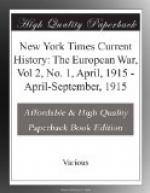Britain’s New and Original Blockade
American Protests Following the “War Zone” Decrees Defined
The first definite statement of the real character of the measures adopted by Great Britain and her allies for restricting the trade of Germany was obtained at Washington on March 17, 1915, when Secretary Bryan made public the text of all the recent notes exchanged between the United States Government and Germany and the Allies regarding the freedom of legitimate American commerce in the war zones. These notes, six in all, show that Great Britain and France stand firm in their announced intention to cut off all trade with Germany. The communications revealed that the United States Government, realizing the difficulties of maintaining an effective blockade by a close guard of an enemy coast on account of the newly developed activity of submarines, asked that “a radius of activity” be defined. Great Britain and France replied with the announcement that the operations of blockade would not be conducted “outside of European waters, including the Mediterranean.”
The definition of a “radius of activity” for the allied fleet in European waters, including the Mediterranean, is the first intimation of the geographical limits of the reprisal order. Its limits were not given more exactly, the Allies contend, because Germany was equally indefinite in proclaiming all the waters surrounding Great Britain and Ireland a “war zone.” The measures adopted are those of a blockade against all trade to and from Germany—not the historical kind of blockade recognized in international law, but a new and original form.
The several notes between the United States and the belligerent Governments follow. The stars in the German note mean that as it came to the State Department in cipher certain words were omitted, probably through telegraphic error. In the official text of the note the State Department calls attention to the stars by an asterisk and a footnote saying “apparent omission.” In the French note the same thing occurs, and is indicated by the footnote “undecipherable group,” meaning that the cipher symbols into which the French note was put by our Embassy in Paris could not be translated back into plain language by the State Department cipher experts. From the context it is apparent that the omitted words in the German note are “insist upon,” or words to that effect.
American note to the belligerents.
The following identic note was sent by the Secretary of State to the American Ambassadors at London and Berlin:
Washington, Feb. 20, 1915.
You will please deliver to Sir Edward Grey the following identic note, which we are sending England and Germany:
In view of the correspondence which has passed between this Government and Great Britain and Germany, respectively, relative to the declaration of a war zone by the German Admiralty, and the use of neutral flags by the British merchant vessels, this Government ventures to express the hope that the two belligerent Governments may, through reciprocal concessions, find a basis for agreement which will relieve neutral ships engaged in peaceful commerce from the great dangers which they will incur in the high seas adjacent to the coasts of the belligerents.




